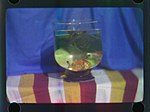Color print film is used to produce color photographic prints, which date to the early 20th century. Initially a two-color process, it became three-color...
6 KB (716 words) - 01:04, 14 May 2024
slide film was offset by not having to pay for prints. Eventually, print quality improved and prices decreased, and, by the 1970s, color negative film and...
21 KB (2,089 words) - 07:42, 7 June 2024
chromogenic print, also known as a C-print or C-type print, a silver halide print, or a dye coupler print, is a photographic print made from a color negative...
16 KB (1,701 words) - 21:16, 26 February 2024
Technicolor (redirect from Color by Technicolor)
with single strip "monopack" color negative film. Technicolor Laboratories were still able to produce Technicolor prints by creating three black and white...
56 KB (7,130 words) - 17:15, 9 June 2024
also used black-and-white film to photograph multiple color-filtered source images, but the final product was a multicolored print that did not require special...
44 KB (6,023 words) - 18:02, 3 June 2024
Negative (photography) (redirect from Color negative)
automatic color-masking feature that ultimately results in improved color reproduction. Negatives are normally used to make positive prints on photographic...
12 KB (1,141 words) - 14:26, 1 June 2024
stage, corrections in the film's density and color are corrected (timed) to the filmmakers' tastes. Interpositive (IP) prints are struck from the OCN,...
27 KB (3,759 words) - 12:06, 21 April 2024
that a given film can tolerate, while still producing an acceptable level of quality, is called its exposure latitude. Color print film generally has...
72 KB (8,910 words) - 12:02, 4 April 2024
The color balance may need to be corrected during printing to achieve a neutral color print. The extent of this correction is limited since color film normally...
29 KB (3,279 words) - 07:09, 8 June 2024
present in white light (CMY color, used for prints on paper and transparencies on film). Monochrome images which have been "colorized" by tinting selected areas...
64 KB (8,691 words) - 00:00, 6 June 2024
The salt print was the dominant paper-based photographic process for producing positive prints (from negatives) from 1839 until approximately 1860. The...
5 KB (441 words) - 22:24, 5 August 2023
color of black-and-white photographs. In analog photography, it is a chemical process carried out on metal salt-based prints, such as silver prints,...
9 KB (1,036 words) - 00:07, 8 May 2024
reversal camera films, intermediate stocks, and print stocks. 3M no longer manufactures motion picture film. CR 160 Camera Reversal Film 16mm B&W (negative...
39 KB (3,587 words) - 16:17, 7 April 2024
such, color spaces are an essential tool for color reproduction in print, photography, computer monitors and television. The most well-known color models...
50 KB (5,728 words) - 01:13, 1 June 2024
for each of the three primary colors. The final print, however, was a single full-color strip of film that did not need any special handling. This became...
73 KB (590 words) - 22:33, 8 June 2024
The CMYK color model (also known as process color, or four color) is a subtractive color model, based on the CMY color model, used in color printing, and...
17 KB (1,829 words) - 12:16, 6 June 2024
Color Consortium. Retrieved 26 April 2021. Homann, Jan-Peter (2009). Digital color management : principles and strategies for the standardized print production...
84 KB (9,821 words) - 04:26, 29 May 2024
A color space is a specific organization of colors. In combination with color profiling supported by various physical devices, it supports reproducible...
22 KB (2,653 words) - 03:07, 5 June 2024
The RGB color model is an additive color model in which the red, green and blue primary colors of light are added together in various ways to reproduce...
43 KB (5,163 words) - 17:12, 9 June 2024
of integral instant film is not as high as conventional film, peel apart black and white film (and to a lesser extent color film) approached the quality...
44 KB (5,166 words) - 13:44, 2 June 2024
a print of any size: the photographer has direct control over cropping and aspect ratio from the original, unmolested image on film; and many film scanners...
5 KB (644 words) - 23:37, 11 April 2024
changing color appearance in film reproduction when going to the answer print or release print in the film reproduction chain. By the late 2010s, this film grading...
17 KB (2,353 words) - 12:12, 8 February 2024
Storing Color and Black-and-White Films and Prints. Grinnell, Iowa : Preservation Publishing Company, 1993. National Film Preservation Foundation The Film Preservation...
12 KB (1,672 words) - 23:05, 11 April 2024
Infrared photography (redirect from Color infrared film)
are used together with infrared-sensitive film or sensors, "in-camera effects" can be obtained; false-color or black-and-white images with a dreamlike...
34 KB (4,213 words) - 00:02, 5 June 2024
Darkroom (section Print processing)
development of the film to the creation of prints, the darkroom process allows complete control over the medium. Due to the popularity of color photography and...
6 KB (747 words) - 22:59, 6 October 2023
Gelatin silver process (redirect from Gelatin silver print)
and is the fundamental chemical process for modern analog color photography. As such, films and printing papers available for analog photography rarely...
17 KB (2,234 words) - 17:41, 27 October 2023
multi-color print with a spot color process, every spot color needs its own lithographic film. All the areas of the same spot color are printed using the...
5 KB (623 words) - 23:25, 14 October 2023
C-41 process (category Photographic film processes)
C-41 is a chromogenic color print film developing process introduced by Kodak in 1972,[citation needed] superseding the C-22 process. C-41, also known...
12 KB (1,449 words) - 20:52, 23 January 2024
The albumen print, also called albumen silver print, is a method of producing a photographic print using egg whites. Published in January 1847 by Louis...
7 KB (704 words) - 10:16, 11 May 2024
List of photographic processes (section Color)
Ap-41 process (pre-1978 Agfa color slides; 1978-1983 was a transition period when Agfa slowly changed their color slide films from AP-41 to E6) Anthotype...
5 KB (390 words) - 22:10, 7 May 2024





















